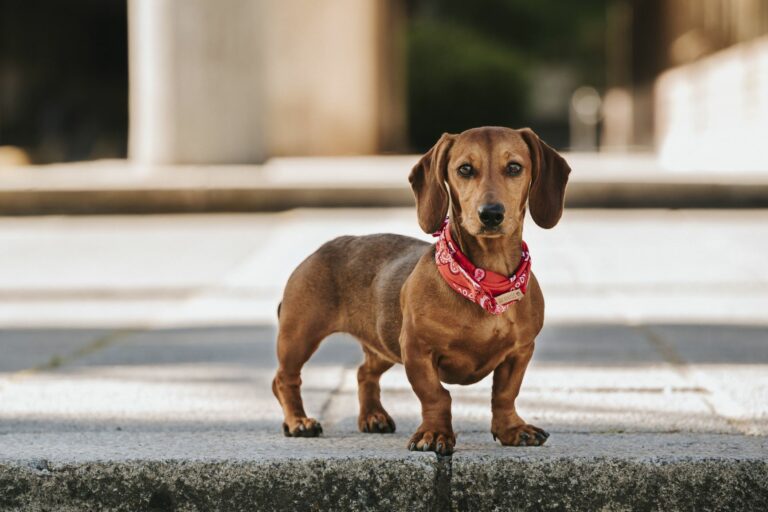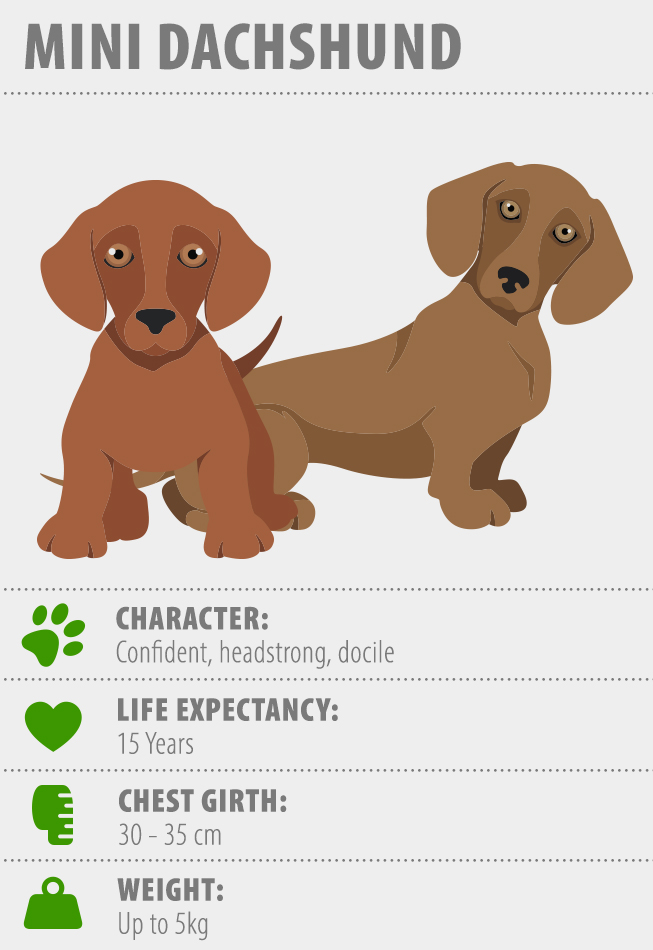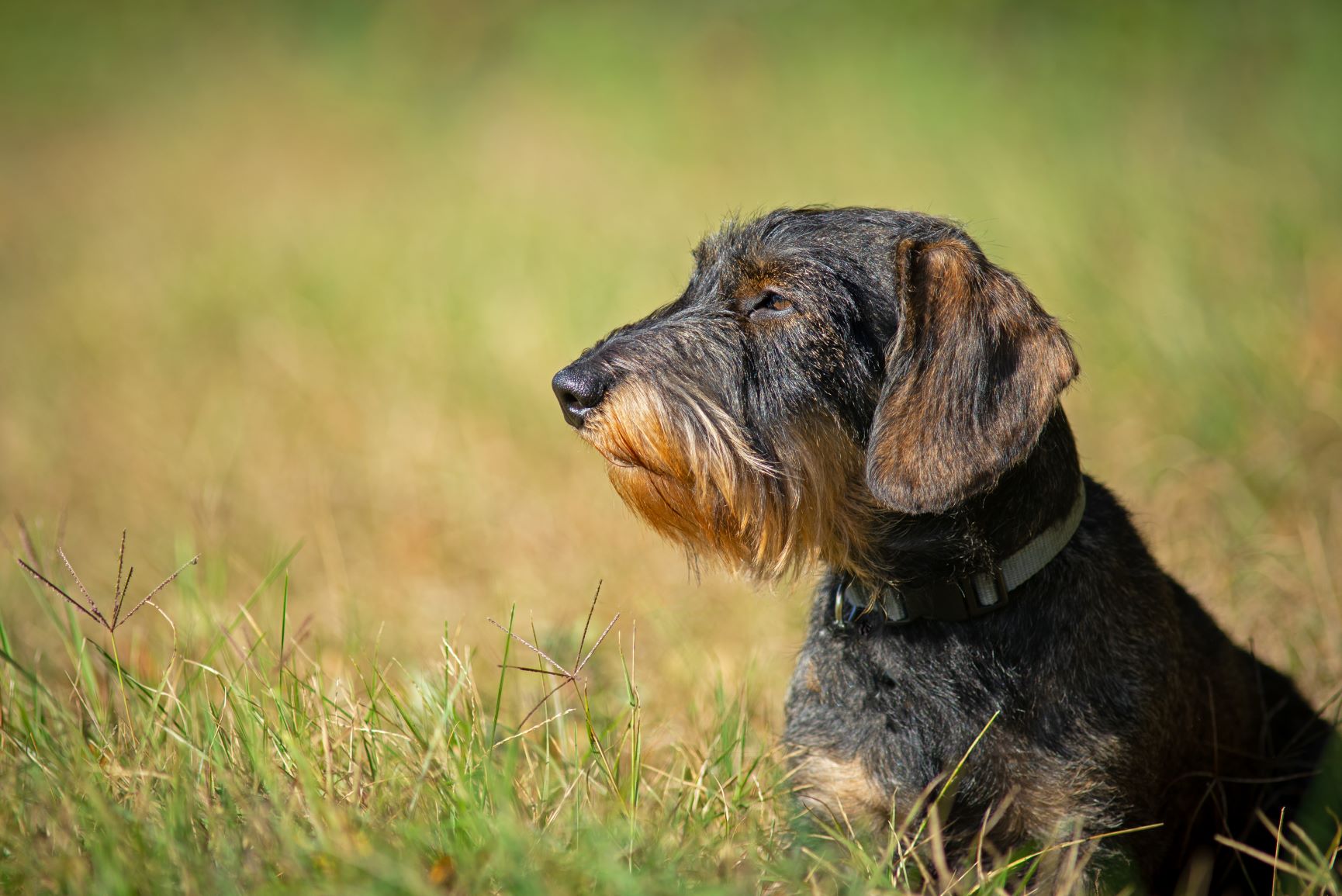Beagle
The Beagle's short legs can be deceiving – this medium-sized dog keeps you on your toes and is always full of surprises! This friendly breed is active, fearless and extremely clever.
Miniature Dachshunds aren't an individual breed, but a variety of the well-known Standard Dachshund. These little characters are most popular as family and companion dogs.

© Wirestock / stock.adobe.com
Miniature Dachshunds are a variety of the Dachshund.
Whilst the normal Dachshund has a chest circumference of over 35 centimetres, this is between 30 and 35 centimetres with Miniature Dachshunds. The Miniature Dachshund certainly isn’t the smallest: The Rabbit Dachshund variety has a chest circumference of less than 30 centimetres.
Rabbit Dachshunds aren’t called that because they are small like rabbits, but because they fit even in the tiny entrances of rabbit holes.
All Dachshund sizes can be found with the three common Dachshund fur varieties:
 © zooplus
© zooplus
The Dachshund is found in many different brown tones, such as boar-like pig brown, but not in black and white. The long build in relation to the short legs is typical of the breed.
Find out here about the Standard Dachshund.
Like its big brother, the Miniature Dachshund is a real personality!
It takes great self-confidence for a Dachshund to hunt a much larger badger. The Miniature Dachshund has this in spades.
It resembles the Standard Dachshund in nature. All Dachshunds are considered headstrong and excellent hunters. The fur variety can play a role here: Coarse-haired Miniature Dachshunds are said to be particularly daring and with great enthusiasm for hunting. This is due to their terrier heritage.
Longhair varieties tend to form the closest bond to their human family and are particularly sensitive. Exceptions may prove the rule, but it’s clear that all Dachshunds have huge personalities!
Loving consistency and abundant patience are the path to obedience for all Dachshunds. This is the case for both Miniature and Rabbit Dachshunds. They need clear leadership and plenty of exercise and activity despite their small size.
Since hunting is their favourite hobby, you should factor in plenty of time for anti-hunt training. Miniature Dachshunds deployed for hunting undergo professional hunting dog training from an early age.
 © anna pozzi / stock.adobe.com
© anna pozzi / stock.adobe.com
Is this little breed with full-on puppy dog eyes right for every household? Only if you don’t underestimate the requirements of the breed.
Grooming is easiest with shorthair Miniature Dachshunds. Slightly more time is needed for grooming longhair Dachshunds. Their long, silky coat is prone to matting if it is not combed regularly.
Groomed coarse-haired Dachshunds barely moult. However, anyone who chooses these dogs needs to spend some time on grooming – or regularly see a dog groomer. Matting develops quickly most of all on the ears, between the legs, on the abdomen and beneath the tail.
Trimming is also required every two or three months with the Miniature Dachshund. Otherwise, dead hair gets stuck in its fur, which can lead to terrible itching. You can get an expert to show you how to trim or leave it to a dog groomer.
If it gets enough exercise, a Miniature Dachshund is suitable for living in cities and apartments, as well as in the countryside. However, you should be out and about with your dog for several hours per day. A short walk through the local park isn’t sufficient for these hunting dogs.
Do you live on the fifth floor and don’t have a lift? Due to its anatomy, the Dachshund shouldn’t have to climb many steps on a regular basis. An adult Dachshund can of course tackle steps in day-to-day life. If in doubt though, you should carry it if there are a lot of steps.
Miniature Dachshunds and slightly older children can get on wonderfully if the Dachshund is well socialised. Make sure that the Dachshund doesn’t get overwhelmed and is able to retreat.
Can a Miniature Dachshund live well with cats? This works best if a Dachshund puppy encounters a fully-grown feline. Although the size difference is only minimal, fleeing cats can trigger the Dachshund’s hunting instinct.
As small and cute as it may look, digging and hunting are in the blood of both Miniature and smaller Rabbit Dachshunds. It’s not uncommon for Dachshund owners to report their dogs going on their own forays in the woods.
You shouldn’t take this lightly. The dog might become a poacher or even come into conflict with wild animals in a foxhole. If your Dachshund does not hunt on a professional basis, offer it alternatives such as search and tracking games. Many Dachshunds also enjoy intelligence games or learning little tricks.
Dachshunds like spending time outdoors and are anything but couch potatoes. Due to their size and short legs, Miniature and Rabbit Dachshunds don’t make suitable jogging companions. However, adult Dachshunds like going on long walks.
If you’re looking for a Miniature or Rabbit Dachshund, you should place great importance on a reputable breeder, because this breed comes with some potential health problems.
At first glance, it is noticeable that the Dachshund’s back is disproportionately long in relation to the legs. The cause for this is chondrodysplasia, a long-standing mutation. This leads to the growth plates on the legs ossifying before growth is complete. As a result, the legs remain short. Dachshunds are more regularly affected by a certain type of slipped disc called chondrodystrophy due to their disproportionately long spine.
Weight gain and too little exercise increase the risk of chondrodystrophy. Make sure that your Miniature Dachshund stays in shape and doesn’t gain too much weight. Miniature and Rabbit Dachshunds have an average life expectancy of up to 15 years.
So you’ve decided that it’s going to be a Miniature Dachshund! Then get tips on making a purchase here.
An accidental mutation leading to short legs made this popular dog breed possible. The oldest Dachshund variety is the shorthair, which was followed by the longhair. Coarse-haired Dachshunds that resulted from pairing with terriers are most popular for hunting.
The Miniature and Rabbit Dachshund varieties emerged in breeding over 100 years ago, because they fitted even better into the dens of wild animals.
You will find that some breeders specialise in one fur variety of Miniature Dachshunds, whilst others breed several Dachshund sizes and fur types.
Reputable breeders will belong to an association and give away their dogs with the relevant pedigree certificate.
If you would like to offer an older dog a home, you could strike lucky in an animal shelter or contact a Dachshund welfare association. You can always find older dogs looking for a new home on other websites too.
Regardless of where you purchase your Miniature Dachshund, find out beforehand about the dog’s hunting aptitude. Dachshunds from hunting breeds are generally only given away to hunters.
Dachshund lovers will say that Dachshunds are unique and incomparable. However, if you are open to other small dog breeds, you will find that terriers in particular are similar to Miniature Dachshunds. For instance, the Sealyham Terrier can be deployed for hunting badgers. It is considered very socially tolerant for a terrier and weighs a maximum of 9 kilograms.
Norfolk Terriers and Norwich Terriers are also friendly little hunters. The Skye Terrier has short legs and a headstrong personality.
As much as the Miniature Dachshund melts the hearts of dog lovers with its puppy-dog eyes, you shouldn’t underestimate it. The Dachshund is and always will be a personality of its own in every size, sometimes with a significant hunting instinct. If you value this and can steer it in the right direction, you will have made a wonderful friend in the Miniature Dachshund.
The Beagle's short legs can be deceiving – this medium-sized dog keeps you on your toes and is always full of surprises! This friendly breed is active, fearless and extremely clever.
The Golden Retriever is still one of the most popular dog breeds, especially with families. It is defined not just by its docility, but shows numerous other qualities too. Read in the following article everything you need to know about the Golden Retriever.
The German Shepherd is one of the most popular utility dog breeds in the world, though the willing-to-learn and people-focused nature of these versatile dogs also makes them suitable for family life.